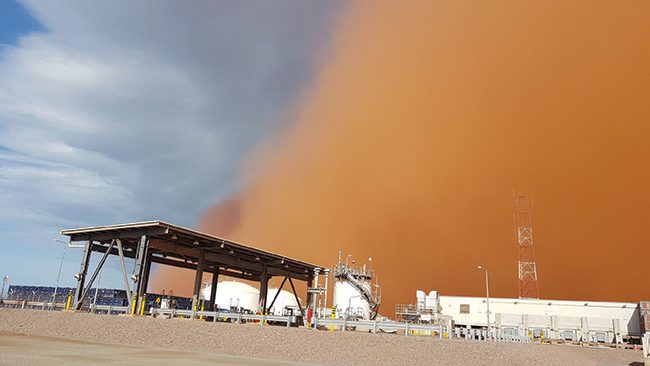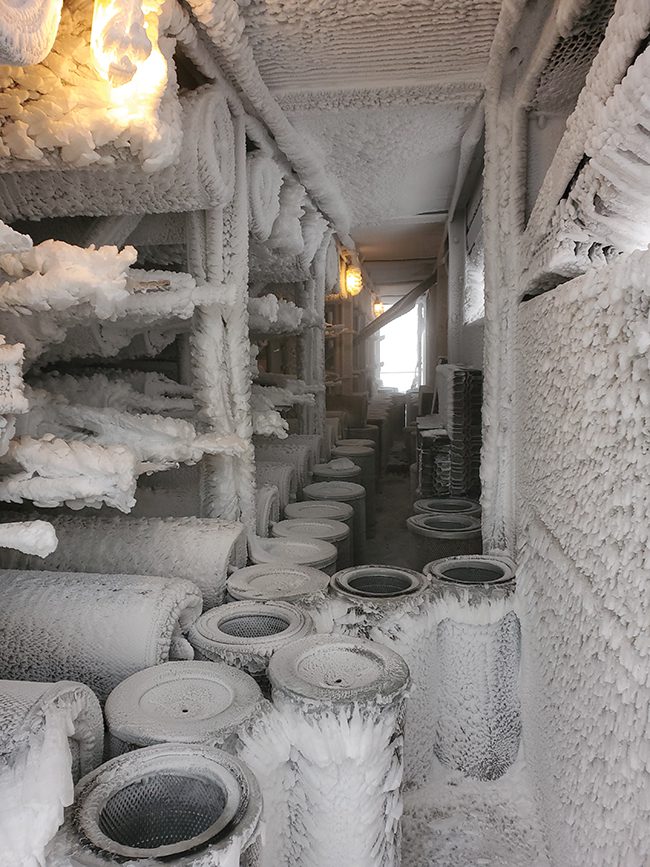Protecting Gas Turbines from High Temperatures, Humidity, and Dust
Gas turbines require high-quality air to operate reliably. However, increasing temperatures and reduced rainfall are increasing the frequency of dust storms in many parts of the world. In these circumstances, air filtration technology plays a critical role in ensuring satisfactory operation regardless of the ambient conditions.
With the increasing pressure of more environmentally friendly energy and the drive to reduce fuel burn, investments and continual improvements are being made to advance the efficiency of gas turbines (GTs). The challenge to reduce fuel burn in a gas turbine is being achieved using exotic metals and advanced manufacturing techniques to improve aerodynamics and the throughput of air. These improvements are compromised by climate changes that are impacting temperature, humidity, and the types and amounts of particulates in the air that is fed to the GT.
Olivia Lazard, scholar at Carnegie Europe, was recently interviewed by the Center for Strategic and International Studies (CSIS) and said, “Even if we were to manage to stay at a 1.5-degree-Celsius increase, the Middle East and the North African regions would still experience a substantial rise in temperatures, which would mean more drought—more issues around access to water.”
Increasing temperatures and reduced rainfall are increasing the frequency of dust storms in the Middle East (Figure 1). In 2016, the United Nations Environment Programme said Iraq could suffer 300 dust storms a year within a decade. A report from the United Nations General Assembly stated: “Sand and dust storms have become increasingly problematic in the water-scarce Arab region. They have expanded in geographical scope, likely because of climate change and changing environmental conditions such as land use and land cover change.”
 |
|
1. As local environments see less moisture, sand storms similar to this will become more common. Courtesy: Parker Hannifin |
According to the Intergovernmental Panel on Climate Change (IPCC), North America will also experience significant rises in temperature: “Under all future scenarios and global warming levels, temperatures and extreme high temperatures are expected to continue to increase (virtually certain) with larger warming in northern subregions.”
Some areas will experience much higher rainfall and rising temperatures will mean significant increases in humidity, as cited by a PNAS (Proceedings of the National Academy of Sciences) research article: “One of the most robust findings of most if not all climate model studies is that increase in SAT [surface air temperature] leads to increase in humidity.”
But what does all this mean for the performance of high efficiency gas turbines? Whether regions are becoming hotter and drier, or whether rainfall and humidity are increasing, these can have numerous impacts on GTs and the filtration systems that are installed to protect them, including:
- ■ Increased humidity promotes corrosion and can lead to sudden pressure spikes if filtration systems protecting the turbine suddenly become blocked.
- ■ Filtration systems need to efficiently handle greater volumes of dust and sand, which pits and erodes precisely engineered metal parts in the turbine, without becoming blocked or requiring unacceptably high levels of maintenance or replacement.
- ■ Higher ambient air temperature has an inverse relationship with the efficiency of the GT. As site temperatures rise the importance of reducing differential pressure (DP) in the inlet house through media selection becomes more important to offset the loss of efficiency.
Ultimately, high-efficiency GT compressors require high-quality air to ensure robust operational behavior. Therefore, stable and predictable air filtration technologies play a critical role in ensuring fuel burn remains low regardless of changing ambient conditions. But how can we be sure the GT is protected? Filtration systems are evolving to meet extreme demands, but how can we be sure these systems will operate as expected when installed?
Tackling Moisture and Humidity
Increases in levels of moisture or humidity can pose several issues for filtration systems. Tiny water droplets (moisture) present in fog or mist (Figure 2) can become easily trapped within certain types of filtration media and mix with dust to form mud. This can quickly block the filters, creating large and sometimes sudden pressure losses in the system. Moisture also causes quick changes in the physical state of hygroscopic salt particles from solid to liquid form, making them more challenging for the filtration system to handle.
 |
|
2. Fog events are becoming less predictable, requiring year-round moisture mitigation. Courtesy: Parker Hannifin |
Coalescers are used to agglomerate the water droplets to make them larger and heavier. This prevents moisture and liquid-phase corrosives from reaching and then entering the tiny pores in the GT filter media. A further problem can come where moisture is present from mist or fog events and there is high volumes of dust or sand in the environment. This can result in the need for frequent replacement of coalescers. In such circumstances, the coalescer needs to be designed to allow dry dust and sand to pass through while removing the free moisture. Such technology is available and will significantly reduce maintenance overheads.
A further consideration is the type of media used within the filters. Cheap blended media swells, reducing the effectiveness of the filter; whereas, the selection of a system using advanced fully synthetic media will help ensure filter performance, and in turn, GT performance, is maintained.
Metal parts of filtration units also need to be protected from corrosive damage due to high levels of humidity. Selecting filters that use powder coatings on metal parts of the cartridge will increase their reliability and resistance to environmental factors. Waterproof coatings using cross-linked materials will further increase the filter’s resilience to cracking, peeling, chipping, and abrasion.
In addition to upgrading the protection of the metal, climates that have increased moisture will need to consider upgrades in media selection. Sites that historically used blended media will experience economic benefits by upgrading to synthetic materials that perform well (providing lower inlet DP and higher GT efficiency) in higher moisture environments.
Combating Increasing Dust Levels
High volumes of dust or sand require multiple stages of filtration using increasingly fine media, which is pleated into panels to maximize the filtration area and optimize filtration efficiency. To protect the GT and ensure smooth ongoing operations, the filters need to handle the large volumes of dust so that they remain robust and there is no opportunity for fast-flowing sand and moisture in the airflow to bypass the filter media and damage GT internals.
Using polyurethane flow technology in the filter construction will ensure complete encapsulation of the media pleats and help protect against damage, through which air can bypass the filter media. In high-moisture environments, it may also make sense to use edge seal technology, which applies continuous hot-melt beads at the border of the pleats to act as a secondary reinforcement seal against the moisture.
In dusty regions, self-cleaning pulse systems enable lower differential operating pressure, which increases the efficiency of the gas turbine. However, the pulse settings of these systems need to be optimized depending upon the location and prevailing environmental conditions. It is also crucial that the system is properly maintained, including the supply of air to it.
Assuring Filter Performance: Extreme Dust Testing and Testing Real-World Conditions
Although we recognize the challenges a changing environment can present on GT operations, how can we be sure that filtration systems will operate as predicted once installed on-site? Given the huge volumes of air a GT consumes, even the smallest change in performance can make a huge difference to power output and efficiency.
The volume of air required to test GT filters makes it difficult to control the many environmental variables reliably in a laboratory setting. This can mean results are at risk of variation according to the time of year tested and changing weather conditions in the local environment from which air is drawn (Figure 3). The length of test will further determine how close it is to site conditions as filter performance changes over time.
 |
|
3. In February 2021, an arctic blast hit seven southern states. Courtesy: Parker Hannifin |
The true test of filter lifetime performance goes way beyond just filtration media efficiency. Accurate and reliable test conditions need to be established and, if testing does not simulate real-world conditions, there are no guarantees the filters will perform in the same way on-site.
Real-world testing, using mobile test rigs, offers the most assured way to predict and understand the performance of a filter. Investing in large test rigs that can fully simulate sandstorm conditions over prolonged periods also provides filter manufacturers with the insights they need to ensure filters are robust, resilient, reliable, and predictable, as sand, moisture, and dust levels become increasingly less predictable.
High-Quality Filtration Is Vital to Success
The ever-changing climate is having an impact on regional weather trends. The calculus previously used about local site conditions doesn’t necessarily apply to current site conditions. If we are to maintain the performance of high-efficiency turbines over time, we need to ensure filters, media, and auxiliary systems used to protect them are optimized for current conditions.
We can no longer rely on stagnant site analysis at first fire. Said another way, filtration system recommendations need to be dynamic and relevant to actual conditions as opposed to past condition assumptions. This is where the expertise of application engineering teams needs to be nimble. They must align and specify filter systems at sites based on actual weather conditions, local industry, and inlet house orientation. It is vital that they stay in touch with changing weather patterns and challenge past assumption when making recommendations on filtration systems.
—Tim Nicholas is PowerGen market manager for Parker Hannifin’s Gas Turbine Filtration Division.